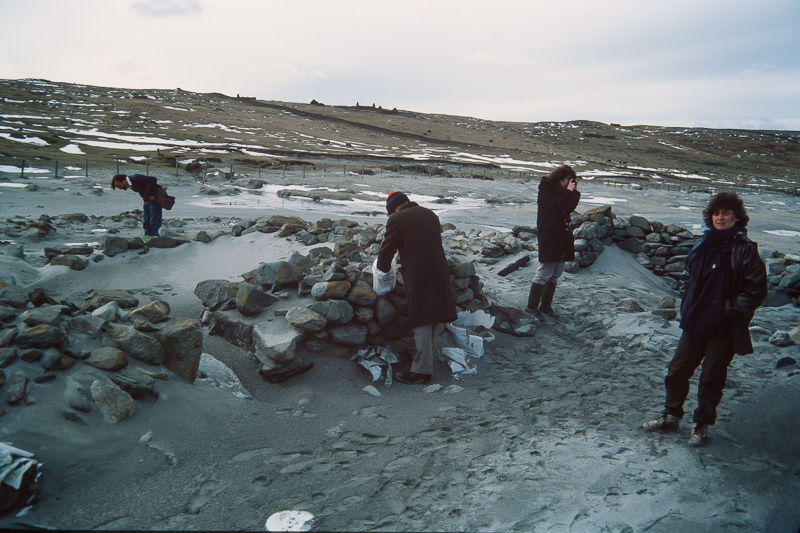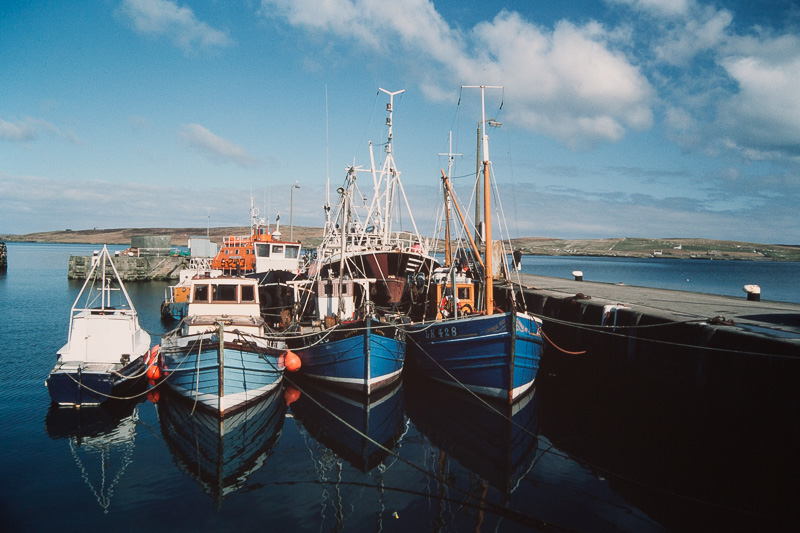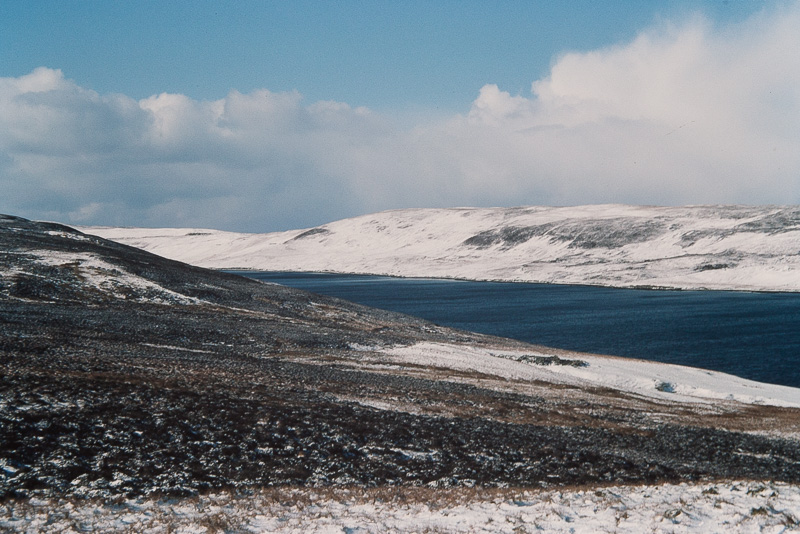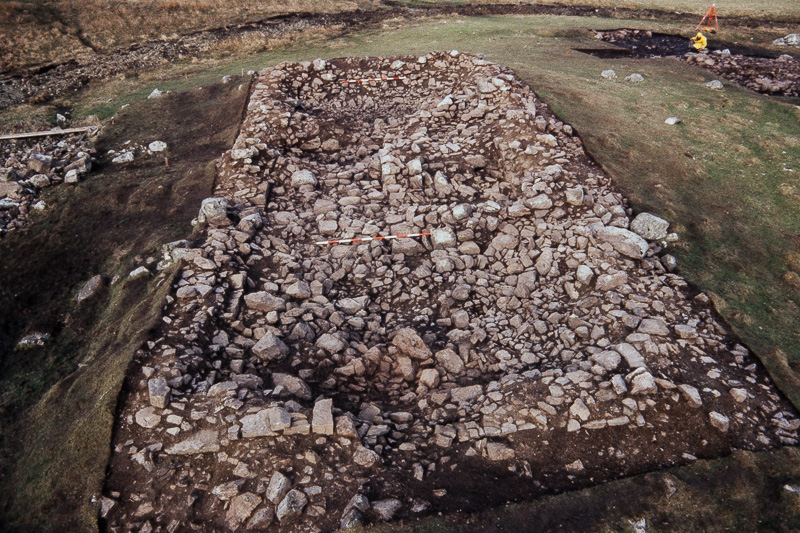Thirty years ago today, on 20th March 1985, a 19-year-old me set sail for Shetland. There I go, up to my new trick of counting in decades again. Thirty years. How did that happen?
I didn’t realise it at the time, of course, but, as life events go, Shetland 1985 turned out to be right up there. Not that anything particularly dramatic happened—apart from a number of explosions—but my three weeks on Britain’s northernmost sub-archipelago changed certain aspects of my outlook on life. For the better, I like to think.
I was in my second year at Durham University at the time, studying for a degree in Natural Sciences, part of which comprised a two-year course in scientific techniques in archaeology. One requirement of this course was that I take part in an archaeological dig. Hence my trip to Shetland.
I wish I could say that I still vividly recall everything that happened that Easter. The truth is, like the Sixties, if you can remember Shetland 1985, you probably weren’t there. The work was hard, but so was the play. We somehow managed to survive on around four hours’ sleep a night. When we weren’t digging, we were out drinking, or occasionally sightseeing.
One thing I’ll certainly never forget is the overnight ferry from Aberdeen. I’d never been on a ship before. The crossing was so rough that, as I lay in my bunk, first my feet, then my head kept getting thrown violently into the bulkhead as the ship pitched through the waves. Sleep was impossible. It never occurred to me that this was anything other than normal until, as we entered calmer waters approaching Lerwick the following morning, the captain announced, in case we hadn’t already guessed, that it had been an extremely rough crossing.
There were two other students on the dig (or studios, as the proper archaeologists soon dubbed us); two girls. I can’t remember their names. One was from New York. She might have been named Lynne. I would guess there were around ten archaeologists. They were a really nice bunch of people. I can only remember some of their names: Olly, and Magnar (a Norwegian), and two Chrises I think (one of whom I shared a room with, and who might actually have been called Colin), and Gordon, and Mary (who was Irish), and Dave, and Mandy. Until I dug out my old Kodachrome slides last week, I’d forgotten there was also a baby and a dog on the dig. I think the dog’s name might have been Rosie. Or maybe that was the baby. Holy crap, that baby will be thirty now: ten years older than I was back then!
We studios arrived on the first day of digging, the preliminary site surveys having already been carried out. The site was at the former settlement of Kebister, a stone’s throw from the southern shore of Dales Voe, an inlet just north of Lerwick. There were some interesting bumps in the ground, which, it was thought, might be medieval, possibly Viking, in origin. But nobody really knew. The dig was a rescue dig, to salvage what we could before the site was destroyed by the construction of a new quay for an oil rig supply base. Construction was already underway. Because it was a rescue dig, speed was of the essence. This meant, amongst other things, that we would be expected to carry on digging in pretty much all weathers. Unfortunately, Easter in Shetland isn’t famous for its clement conditions.
I have to say, my three weeks on Shetland were, without doubt, the three coldest weeks of my life. We had been warned to bring plenty of warm clothes, including long johns, which I ended up living in 24 hours a day. I wore out two pairs of gloves, which I wore one inside the other. We dug in all weathers, even blizzards. You’d scrape away some soil, turn to put it in your bucket, and, when you turned back, you could no longer tell where you’d been scraping. There was rain as well. Most mornings, we would spend the first half-hour bailing out our previous excavations, until I jokingly suggested that we ask the quay construction workers if they could bring over one of their JCBs and dig us a drainage ditch above the site. This turned out to be a brilliant suggestion, and it was soon arranged. Oh, yes, as I said, there were also explosions: a siren would sound from the construction site, followed shortly afterwards by a loud but dull thud. It was all very Indiana Jones, but with more snow.
As I was only there for the first three weeks of the dig, I didn’t get to see most of the excavated structures and associated finds. By the time I left, we had uncovered the remains of a large, rectangular building and a kiln. I later learnt that the rectangular building was believed to have been an early sixteenth-century tithe barn (or teind barn, as they’re called in Scotland), although the remains of a much older, prehistoric oval stone house were also found. Subsequent digs explored other structures in the vicinity.
During the dig, I earned myself a reputation for being jinxed when it came to finds. I would excavate for several hours, then be moved, only for someone else immediately to uncover something interesting at the precise location I’d just vacated. I was assured this was simply down to incredibly bad luck, not bad technique. I didn’t uncover anything of the remotest interest until my penultimate day’s digging: 136 snail shells in what appeared to be a small rubbish dump (or midden, to use the archaeologists’ preferred term). 136 snail shells do count as remotely interesting, I suppose.
But Shetland wasn’t all about digging. The majority of us would go out to the pub most evenings. Two of the archaeologists (or alcohologists, as we studios soon dubbed them) were musicians: the Chris who might have been Colin played the penny whistle and button accordion, while Gordon played the washboard and spoons (I use the word musician in its most charitable sense). In no time at all, they were jamming with the local fiddlers, earning us all free rounds from some of the more generous landlords. The Shetland folk were incredibly friendly. We’d made the local newspaper, and were treated like minor celebrities wherever we went. Having a Norwegian in our group made the locals even friendlier. Shetlanders have a thing for Norwegians.
One evening, we decided to head off in search of a country pub. Fortunately, the Chris who was definitely a Chris didn’t drink, so volunteered, as always, to drive the van. We drove for about 10 miles, until we finally found a dimly lit pub in the middle of nowhere. We couldn’t make out the sign outside, and weren’t sure whether it was open, but we ploughed in regardless, only to find ourselves standing in the lounge of an old people’s home, being offered tea and biscuits.
The most (and least) memorable night out, however, came on 2nd April: my twentieth birthday. We ended up, as nearly always, in a pub in either Scalloway or Lerwick, I forget which, where the gang bought me a special cocktail devised by Gordon. He named it an ‘ants in your pants’. I can’t remember what was in it, but it involved a subtle blend of spirits served in a brimming pint glass—which goes a long way to explaining why I can’t remember what was in it. Towards the end of the evening, at about 1:30am (official licensing hours were routinely ignored), the landlady approached me to ask how ‘the one with the drink’ was getting on. She was stunned when I assured her that I was fine. I certainly wasn’t fine when my alarm clock went off just 4½ hours later.
On Sundays, we took trips out, mainly to visit archaeological sites. We travelled the full length of Shetland, from the prehistoric and Norse settlement at Jarlshof on Sumburgh Head to the cliffs overlooking Muckle Flugga lighthouse and Out Stack, the most northerly points in the British Isles. In all that distance, we saw about six trees.


The three weeks flew by, then it was time for the ferry trip home. This time, the North Sea was a millpond.
✽
I never saw any of my friends from the dig ever again. This was in the days before email, Facebook, and text messages. I did see Mandy on television a couple of years back, being interviewed at a Roman archaeological site by Prof. Alice Roberts. She hadn’t changed much, although she’s called Amanda these days.
As for the site at Kebister, while I was fact-checking this article as best I could last week, I was surprised and delighted to discover that the excavated site is still there. It’s quite clearly visible on the Bing maps aerial photo, immediately adjacent to the new (well, 30-year-old) quay. It turns out that, shortly after I left, the Lerwick Port Authority was prevailed upon to change the plans for the new quay in order to preserve the archaeological site. The quay is due to be extended soon, however, so perhaps the site’s days are once again numbered.
How did Shetland change my outlook on life? Well, for a start, it gave me a fondness for traditional folk music, which some of my friends still find baffling. More importantly, it also helped change my political views. Before Shetland, I’m ashamed to say, I had voted Conservative. The bitter Miners’ Strike had only just finished, so I took some gentle digging (pun intended) from my left-leaning archaeologist friends. They were right. I’ve never voted Tory since—and never will.
But perhaps the biggest change wasn’t really a change at all; more a realisation. In the days leading up to my twentieth birthday, I was rather dejected: “I’m going to be twenty,” I kept moaning to anyone who would listen: “I’m going to have to grow up, and start being responsible, and sensible, and all that stuff!”
Nursing the mother of all hangovers the morning after my twentieth birthday, I experienced a sudden revelation: No I don’t!
Thirty years later, with fifty looming, I’m still resisting growing up.






Leave a Reply